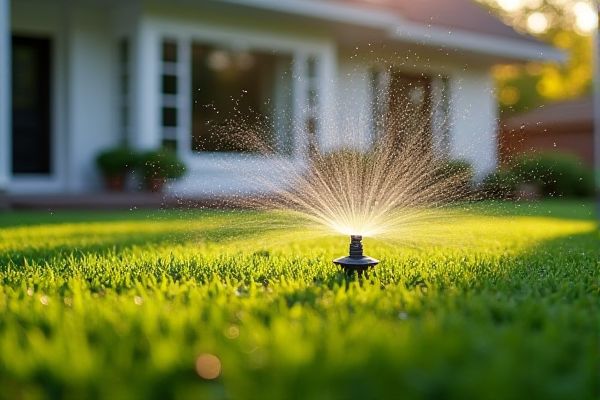
Drip irrigation delivers water directly to the plant roots, minimizing evaporation and conserving water, while sprinkler systems spray water over a larger area but often experience higher water loss due to wind and evaporation. Understanding these differences can help optimize Your irrigation strategy, so continue reading to find out which system best suits Your needs.
Table of Comparison
| Feature | Drip Irrigation | Sprinkler Irrigation |
|---|---|---|
| Water Efficiency | High (delivers water directly to roots) | Moderate (water spread over larger area, some evaporation) |
| Installation Cost | Moderate to High | Low to Moderate |
| Maintenance | Requires regular checking for clogging | Periodic adjustment and cleaning |
| Suitable For | Row crops, orchards, gardens | Lawns, large fields, uneven terrain |
| Water Pressure | Low to Moderate | High |
| Uniformity | High uniformity at root zone | Variable depending on wind and pressure |
| Evaporation Loss | Minimal | High |
| Soil Erosion | Very low | Possible in heavy application |
Understanding Drip Irrigation and Sprinkler Systems
Drip irrigation delivers water directly to the plant roots through a network of tubes and emitters, minimizing water waste and promoting efficient soil absorption. Sprinkler systems distribute water over a larger area by spraying, simulating rainfall, which can lead to evaporation and runoff. Understanding these differences helps you choose the right system based on your garden size, plant type, and water conservation goals.
Key Differences Between Drip and Sprinkler Irrigation
Drip irrigation delivers water directly to the root zone through a network of tubes and emitters, ensuring high water efficiency and reduced evaporation. Sprinkler irrigation distributes water over a larger area by spraying droplets into the air, which can lead to more water loss due to wind drift and evaporation. Your choice depends on the crop type, water availability, and field conditions, with drip systems excelling in targeted watering and sprinklers suited for larger, uniformly planted fields.
Water Efficiency: Drip vs Sprinkler
Drip irrigation delivers water directly to plant roots, minimizing evaporation and runoff, achieving water efficiency rates of up to 90%. Sprinkler systems spray water over a larger area, resulting in higher water loss due to evaporation and drift, with efficiency typically around 65-75%. Choosing drip irrigation can significantly reduce water usage, making it ideal for conserving water in your garden or farm.
Installation and Maintenance Requirements
Drip irrigation systems require precise installation with emitters placed close to plant roots, demanding regular checks for clogs and leaks to maintain efficiency. Sprinkler systems involve more extensive setup with pipes, valves, and sprinkler heads, needing routine inspection for damage, alignment, and pressure adjustments. Maintenance for drip irrigation tends to be lower cost and labor-intensive compared to sprinkler systems, which often require more frequent repairs and calibration for uniform water distribution.
Cost Comparison: Drip Irrigation vs Sprinklers
Drip irrigation systems generally have higher initial installation costs due to specialized tubing and emitters, but they offer significant water savings that reduce long-term expenses. Sprinkler systems typically involve lower upfront investment but may incur increased water and maintenance costs over time due to evaporation and runoff. Choosing drip irrigation can optimize Your budget through efficient water use and reduced utility bills, especially in areas with limited water resources.
Suitability for Different Crops and Landscapes
Drip irrigation is ideal for row crops, orchards, and gardens requiring precise water delivery directly to the root zone, minimizing evaporation and runoff. Sprinkler systems suit a wide range of crops including lawns, grains, and vegetables, providing uniform water distribution over large or uneven landscapes. Crop type, soil characteristics, and terrain slope determine the most effective irrigation method for maximizing water efficiency and crop yield.
Environmental Impact and Water Conservation
Drip irrigation significantly reduces water waste by delivering water directly to plant roots, minimizing evaporation and runoff compared to sprinkler systems that spray water over larger areas. This targeted approach enhances soil moisture retention and decreases water consumption, contributing to sustainable water conservation practices. Sprinkler systems, while effective for widespread coverage, tend to lose substantial water to evaporation and wind drift, increasing environmental impact.
Common Issues and Troubleshooting
Drip irrigation systems commonly face clogging caused by mineral deposits or debris blocking emitters, requiring regular filter cleaning and flushing to maintain flow efficiency. Sprinkler systems often experience uneven water distribution due to clogged nozzles, broken heads, or incorrect pressure settings, necessitating nozzle inspection, pressure adjustments, and head replacements. Both systems benefit from routine maintenance checks to detect leaks, breaks, and pressure inconsistencies to optimize water usage and prevent plant stress.
Choosing the Right Irrigation System
Selecting the right irrigation system depends on factors such as crop type, soil condition, and water availability. Drip irrigation offers precise water delivery directly to plant roots, reducing evaporation and promoting water efficiency, ideal for row crops and drought-prone areas. Sprinkler systems provide broader coverage suitable for lawns and large fields but may lead to higher water loss through evaporation and runoff.
Final Thoughts: Which System is Best for You?
Drip irrigation offers precise water delivery, minimizing waste and promoting healthier root growth, making it ideal for gardens with diverse plant types or water restrictions. Sprinkler systems cover larger areas efficiently, better suited for lawns or expansive landscapes needing uniform moisture distribution. Your choice depends on your specific plants, landscape size, and water conservation goals.
 homyna.com
homyna.com